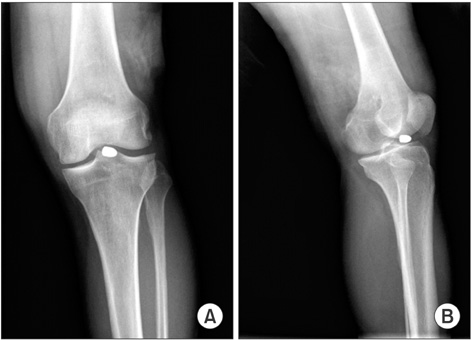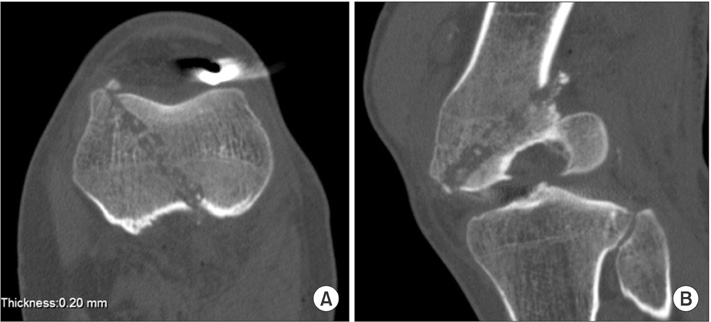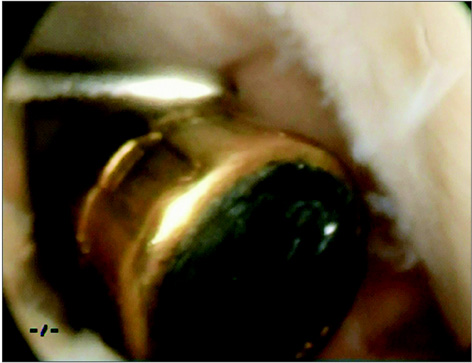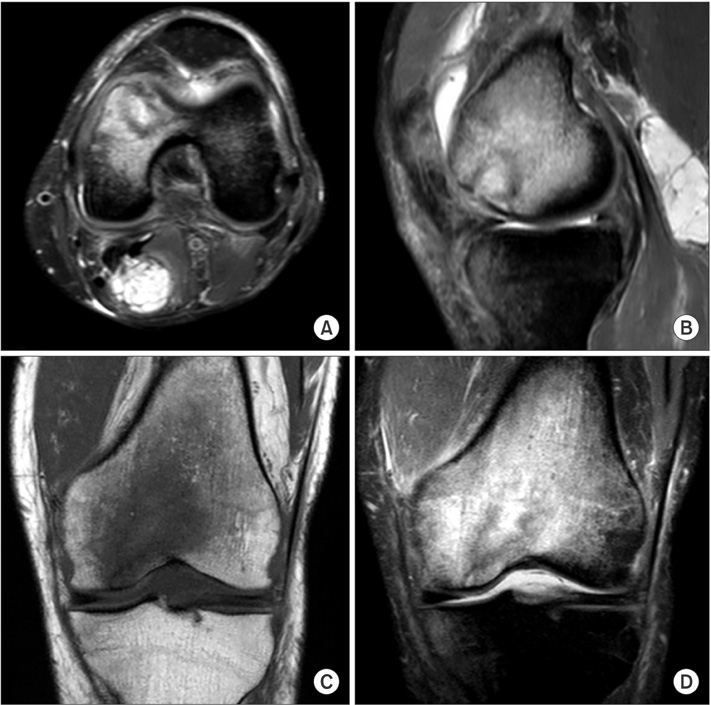Clin Orthop Surg.
2016 Mar;8(1):115-118. 10.4055/cios.2016.8.1.115.
Compartment Syndrome Following Arthroscopic Removal of a Bullet in the Knee Joint after a Low-Velocity Gunshot Injury
- Affiliations
-
- 1Department of Orthopaedics and Traumatology, Istanbul Medipol University, Istanbul, Turkey. mert.keskinbora@yahoo.com
- 2Department of Radiology, Istanbul Medipol University, Istanbul, Turkey.
- KMID: 2363955
- DOI: http://doi.org/10.4055/cios.2016.8.1.115
Abstract
- Gunshot injuries are getting more frequently reported while the civilian (nongovernmental) armament increases in the world. A 42-year-old male patient presented to emergency room of Istanbul Medipol University Hospital due to a low-velocity gunshot injury. We detected one entry point on the posterior aspect of the thigh, just superior to the popliteal groove. No exit wound was detected on his physical examination. There was swelling around the knee and range of motion was limited due to pain and swelling. Neurological and vascular examinations were intact. Following the initial assessment, the vascular examination was confirmed by doppler ultrasonography of the related extremity. There were no signs of compartment syndrome in the preoperative physical examination. A bullet was detected in the knee joint on the initial X-rays. Immediately after releasing the tourniquet, swelling of the anterolateral compartment of the leg and pulse deficiency was detected on foot in the dorsalis pedis artery. Although the arthroscopic removal of intra-articular bullets following gunshot injuries seems to have low morbidity rates, it should always be considered that the articular capsule may have been ruptured and the fluids used during the operation may leak into surrounding tissues and result in compartment syndrome.
Keyword
MeSH Terms
Figure
Reference
-
1. Dicpinigaitis PA, Koval KJ, Tejwani NC, Egol KA. Gunshot wounds to the extremities. Bull NYU Hosp Jt Dis. 2006; 64(3-4):139–155.2. Mulhollan JS. Swedish arthroscopic system. Orthop Clin North Am. 1982; 13(2):349–362.3. Gupta RK, Aggarwal V. Late arthroscopic retrieval of a bullet from hip joint. Indian J Orthop. 2009; 43(4):416–419.
Article4. Diaz-Martin AA, Guerrero-Moyano N, Salinas-Sanchez P, Guerado-Parra E. Arthroscopic removal of an intraarticular projectile from the knee. Acta Ortop Mex. 2011; 25(4):223–226.5. Tornetta P 3rd, Hui RC. Intraarticular findings after gunshot wounds through the knee. J Orthop Trauma. 1997; 11(6):422–424.
Article6. Rehman MA, Umer M, Sepah YJ, Wajid MA. Bullet-induced synovitis as a cause of secondary osteoarthritis of the hip joint: a case report and review of literature. J Med Case Rep. 2007; 1:171.
Article7. McQuirter JL, Rothenberg SJ, Dinkins GA, Kondrashov V, Manalo M, Todd AC. Change in blood lead concentration up to 1 year after a gunshot wound with a retained bullet. Am J Epidemiol. 2004; 159(7):683–692.
Article8. Sclafani SJ, Vuletin JC, Twersky J. Lead arthropathy: arthritis caused by retained intra-articular bullets. Radiology. 1985; 156(2):299–302.
Article9. Peh WC, Reinus WR. Lead arthropathy: a cause of delayed onset lead poisoning. Skeletal Radiol. 1995; 24(5):357–360.
Article10. Pierzchała A, Kusz D, Widuchowski J. Complication of arthroscopy of the knee. Wiad Lek. 2003; 56(9-10):460–467.
- Full Text Links
- Actions
-
Cited
- CITED
-
- Close
- Share
- Similar articles
-
- Penetrating cardiac injury resulting in a bullet embolus: a case report
- Arthroscopic Removal of Loose Bodies from the posterior Knee Compartment using Direct Posterior - Posterior Triangulation
- A Case Report of Spinal Cord Injury Patient From a High Velocity Gunshot Wound to the Lumbar Spine
- Forensic Review of Bullet Embolism
- Long-term Fistula Formation Due to Retained Bullet in Lumbar Spine after Gunshot Injury





